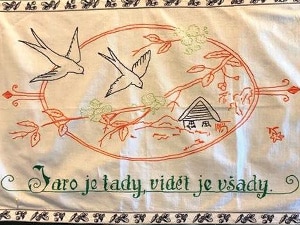Janet Jeffries
In the late 19th century and well into the early 20th century, embroidered wall cloths were common decorative pieces in the rural/village Czech household.
Description
n the late 19th century and well into the early 20th century, embroidered wall cloths were common decorative pieces in the rural/village Czech household. Women embroidered sayings and graphics on simple cotton fabric, sometimes recycled, to decorate their homes. This was done in the same spirit as American women, who made beautiful stitched samplers, and also useful quilts, sometimes out of whatever fabrics were available. The embroidered wall pieces, commonly called either kuchynky, “little kitchen” cloths, or kuchařsky, “cook” cloths, featured motifs often related to housekeeping and cooking, and they were displayed in the kitchen area of the cottages. The phrases, flowers, and designs were applied with simple outline and satin stitches. The cloths were tacked on walls above the kitchen/dining table, wash basin, or work tables. Sometimes they were used as “headboards,” and often were suspended from wall shelves holding religious items to beautify the “Holy Corner.” This program addresses the simple artistry, the sometimes pointed “advice” in the stitched text, and the ways these were used in the home.


